When we go on vacation to the sea, we want to return from there with an even and golden tan. Unfortunately, sometimes the result is completely unpredictable. Even after using special sunscreens, we get dark or white spots on our skin after sunbathing. A photo that shows the picture of the disease is shown below.

This condition does not add attractiveness to the skin. Of course, spots can be covered up, and in some cases, treatment may be necessary. But before taking any measures, you need to find out what is the cause of this unpleasant phenomenon.
Causes
Tanning occurs when the skin is exposed to ultraviolet rays. When sunbathing on the beach, you need to take precautions to avoid unpleasant consequences in the form of burns, pigmentation, and spots on the body. There are a number of reasons why white spots may appear on the skin after sunbathing. These include liver problems, hormonal disorders, kidney and adrenal diseases, decreased immunity, gastrointestinal problems, stress, deficiency of vitamins and microelements, and heredity.
Sunburn
This phenomenon is familiar to many. Prolonged exposure to the scorching rays of the sun leads to burns, which are manifested by redness of the skin, in severe cases it becomes covered with blisters. Skin burns may be accompanied by headache, nausea, and weakness. After the blisters disappear, spots remain on the skin.
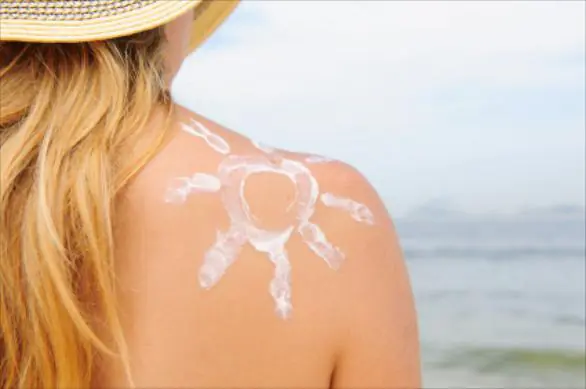
Skin pigmentation
The cause of uneven tanning may be genetic characteristics that lead to the fact that melanin production does not occur in some areas of the skin, which is why white spots appear on the skin after tanning. This condition is called idiopathic guttate hypomelanosis. If you have this condition, do not forget that exposure to the sun can make the spots even more noticeable. This condition, unfortunately, has no cure.
Taking medications
The use of certain medications leads to increased sensitivity and vulnerability of the skin to ultraviolet radiation. The most common medications that cause changes in the skin are birth control pills and antibiotics. These medications interfere with your tan's uniformity, causing your tan to appear patchy. This phenomenon is called photosensitivity of the skin. If you cannot avoid exposure to the sun, you should notify your doctor about this and consult about taking certain medications that may have side effects.
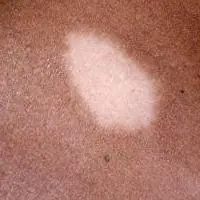
Fungus
White spots on the skin after sunbathing can be the result of fungal diseases. Such ailments lead to the fact that ultraviolet rays do not reach some areas of the skin, and the tan turns out to be uneven. The development of non-contagious forms of the fungus is caused by increased sweating with constant exposure to heat, as a result of which white spots appear on the skin after sunbathing. A specialist will tell you how to treat this disease. In general, the use of special ointments or creams, as well as tablets or antifungal drugs prescribed by a doctor, is recommended.
Vitiligo
With this disease, white spots mainly cover the hands and face. This condition is a warning from the body about serious problems in the functioning of any organs. Even poisoning or disorders of the nervous system can provoke the development of the disease. Only a doctor can establish an accurate diagnosis and prescribe treatment, but, unfortunately, a medicine has not yet been found that can completely eliminate the disease. The condition can be improved with light wave therapy, depigmentation or tattooing.
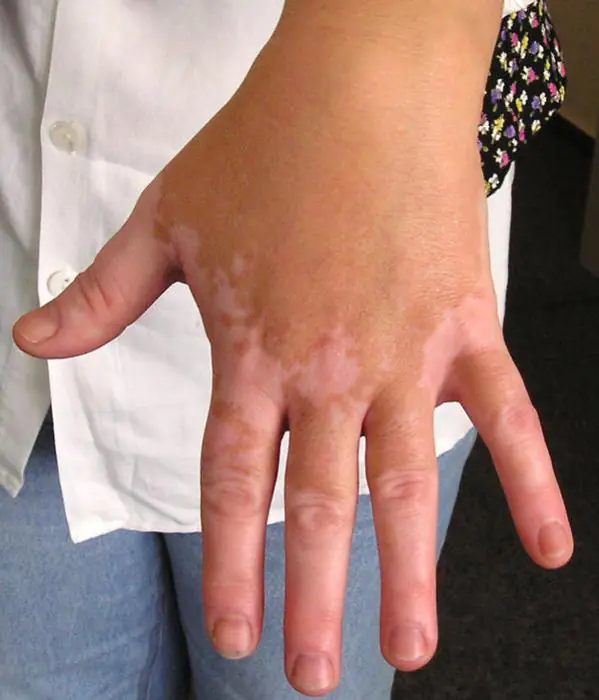
Poikiloderma Siwatt
A sign of this condition, which is not considered a disease, are white spots on the skin after sunbathing. Treatment consists only of using special tanning products. The spots appear only in the neck and chest area. Most often found in people with fair skin. Sunbathing is not recommended until the skin is cleared.
Hormonal imbalances
Problems with the thyroid gland can cause spots on the body. Therefore, prolonged exposure to the sun is contraindicated for women during pregnancy and menstrual periods.
Excessive pressure
This is the most common and harmless cause of skin spotting. Lying down reduces blood flow to areas of the skin that are pressed down. While sunbathing in a solarium, you can find such marks in the pelvic area, on the shoulder blades or elbows. The solution to the problem is quite simple - when sunbathing, you need to change your position more often.
White spots after sunbathing in children
White spots on the skin after sunbathing in a child can be a result of sunburn or as a manifestation of tinea versicolor and vitiligo. The causes of vitiligo in a child may be intestinal dysbiosis, dysfunction of the pancreas, or helminthic infestation. To eliminate the causes of the disease, it is necessary to carry out specific diagnostics followed by treatment.
In addition, such a symptom may be a sign of a rare pathology - hypomelanosis. The disease occurs after severe infectious diseases, which result in damage to the nervous system.
Treatment
In any case, it is necessary to consult a doctor to determine the cause of this phenomenon and prescribe appropriate treatment. Special medications can help with ringworm, but only a specialist should prescribe them. Consultation with a doctor is also necessary for vitiligo. This condition requires a complete examination of the body, as it indicates the presence of problems in its functioning.

If excessive sweating is the cause of your uneven tan, a good anti-sweat product will help. The appearance of white spots while taking medications is an indication for changing the drug. Or you can start sunbathing after the course of treatment ends.
Precautionary measures
White spots on the skin after sunbathing are most often not a sign of illness, but arise from non-compliance with the rules for being in the sun.
You can sunbathe in the morning from 9 to 11 o'clock or in the evening from 16-17 o'clock. This is the safest time to tan.
Don't forget that your skin should get used to the sun's rays gradually. Don't try to get a tan on the first day of your vacation, as this can result in burns and dehydration. Be sure to use protective equipment when tanning.
To avoid stains while sunbathing, do not use decorative cosmetics. The presence of preservatives and other elements in its composition can cause an uneven tan.
How to achieve an even tan?
If spotty skin is not the result of any disease, you can try to make your tan more uniform using simple methods.
When taking a bath, use a stiff washcloth to exfoliate the top layer of skin. This will help get rid of uneven tanning and even out your skin color, which will become a little lighter. Exfoliating scrubs and gels help a lot.
Treatments in a beauty salon will be useful. A specialist will determine the cause of this skin condition and help restore its even color.

Superficial peeling with weakly concentrated fruit acids will eliminate the damaged top layer of skin without damaging the skin. The deep peeling procedure is more traumatic, but very effective.
Uneven tanning can also be eliminated using laser or phototherapy, which destroys melanin. Salon treatments are expensive, so it is advisable to take care of your skin before going to the beach.
Home Remedies
If it was not possible to avoid burns, folk methods will come to the rescue. Sour cream, potato juice, a decoction of oak bark, St. John's wort, and chamomile infusion will help relieve inflammation and reduce pain.
An effective remedy is fruit peeling. To prepare it, take 100 g of pineapple pulp, 50 g of papaya pulp and a few tablespoons of honey. The procedure should not last more than three minutes.
If spots appear on the face, a cucumber mask will help. Grated cucumber is applied to the face for 15 minutes. The procedure must be repeated three times.
Another mask that can help is finely chopped parsley and curdled milk. The components are mixed and used to wipe the face several times a day.
It is better to make masks in the evening to avoid exposure to sunlight.
Sometimes neither preventive measures nor special creams help and white spots still appear on the skin after sunbathing. Your doctor will tell you what this condition is, what its cause is and how to treat it. In this case, it is imperative to contact a specialist, as white spots may indicate disturbances in the functioning of the body.
The appearance of white spots on the skin of an adult or child is not always a sign of a disorder of skin pigmentation (vitiligo). The disease is not life-threatening, but it is difficult to cure. A cosmetic defect often signals a disruption in the coordinated functioning of internal organs.
What diseases are confused with vitiligo
White spots should be shown to a doctor. The earlier, the more successful the treatment.
Pityriasis versicolor – the cause of light spots on the body. Affects the surface of the body, hair. Fungal enzymes interfere with the production of melanin. First, the skin turns pink, then it is replaced by a characteristic whiteness. For treatment, the doctor prescribes antifungal drugs.
Ringworm causes itching, forms a skin ridge, scales. Fungal disease is detected by appropriate research. A non-contagious form of lichen is often confused with vitiligo. For treatment, the doctor prescribes medications.
Leucoderma. The so-called “necklace of Venus” is a manifestation of secondary syphilis. It is found on the arms, under the arms, on the back. Light areas up to a centimeter in diameter do not cause physical discomfort and do not go away for several years. Antibiotic treatment is prescribed by a venereologist.
Traces of abrasions, cuts, burns may raise suspicion of a skin disease. Restoring pigmentation takes several months.
What is vitiligo
Manifestations of the disease are white spots on the skin of a round or oval shape. Lightening is associated with the cessation of the synthesis of melanin pigment, which protects against sunburn from ultraviolet radiation.
Pink or milky white areas appear throughout the body. But more often on the face, arms, groin, elbow bends. They are more noticeable on dark skin, especially in summer against a tanned background. The soles and palms are not affected by the disease - there is no discoloration.
The disease is localized if vitiligo pigment spots are found in a specific area of the body. Or generalized, when they are combined and the depigmented area has covered a significant area.
The disease is most pronounced when the skin is completely discolored, like an albino. The skin remains sensitive, there is no pain.
If the white spot affects the scalp, the hair also loses color. If sebaceous secretion, sweating, and skin sensitivity are impaired, solar dermatitis is diagnosed.
The disease is autoimmune in nature, it affects the age group from 10 to 30 years, and does not occur in the elderly. Vitiligo affects 1-2% of the population. Men and women get sick equally often. The chances of passing it on by inheritance are 1 in 10.
Sometimes vitiligo accompanies skin diseases: lichen planus, focal baldness, psoriasis.
Causes of white spots on the skin
The exact cause of vitiligo is unknown. Factors have been identified that increase the likelihood of spots appearing on the body:
- liver dysfunction;
- ill health of the endocrine system and thyroid gland;
- abnormalities of the pituitary gland;
- kidney and adrenal diseases;
- gastrointestinal diseases;
- immune failure when the body destroys melanocytes - melanin-producing cells;
- infectious diseases;
- stress;
- pregnancy;
- physical trauma;
- imbalance of vitamins and microelements;
- regular contact of the skin with specific types of synthetic fabrics, personal hygiene products, detergents;
- sunburn;
- hereditary predisposition.
When assessing the danger of vitiligo, it is assumed that the lightening of areas of the skin is a consequence of impaired health of organs and systems.
On the other hand, it is dangerous to stop the production of melanin, which protects the skin from sunburn. It is the lack of melanin that causes white spots.
Vitiligo is not contagious because it is not caused by an infection.
Preventing the formation of white spots
If one of your relatives suffered from the disease, simple preventive measures can help prevent vitiligo. Especially in spring and summer, when there are more favorable factors.
- sunbathing, if the body is sweaty, be sure to wipe off the sweat;
- expose the skin to intense wind blowing;
- expose the skin to high air humidity.
Some are convinced that excess vitamin C interferes with the formation of melanin. In fact, insufficient melanin production is a consequence of the disease, not its cause.
Therefore, you should not exclude foods containing vitamin C and vitamin complexes from your diet. Although it is also not necessary to artificially increase its supply.
Skin Spot Removal Nutrition
To prevent cosmetic defects and improve your health, avoid spicy foods: raw onions, ginger, garlic, pepper.
Melanin production is promoted by foods rich in copper (Cu), zinc (Zn), iron (Fe).
These elements are antagonists. Excess supply of one is the cause of deficiency of others. Therefore, pharmacy vitamin complexes are taken in separate courses with a mandatory interval between them.
Copper
Sufficient intake has a beneficial anti-inflammatory effect and slows down the aging process. Copper promotes the absorption of iron, improves the condition of hair and skin, eliminates the white spots of vitiligo, and restores body mobility and flexibility.
Copper deficiency disrupts the synthesis of the thyroid hormone thyroxine, hematopoietic function, and weakens bone and connective tissue. Fatigue sets in faster.
Products rich in copper: cucumbers, pork liver, hazelnuts, cocoa, brewer's yeast, cheese, rose hips.
Zinc
The element is involved in the production of enzymes and is necessary for the functioning of body cells.
Deficiency is the cause of decreased appetite, weight loss, hyperactivity, dermatitis, and hair loss. Lack of zinc weakens the immune system, impairs wound healing and recovery from injuries.
There is a lot of zinc in oysters, brewer's yeast, mushrooms, pumpkin seeds, sunflowers, blueberries, lentils, and nuts.
Iron
Sufficient intake supports cellular respiration, the main participant of which is red blood cells (erythrocytes). They deliver oxygen to tissues and remove carbon dioxide using hemoglobin. Iron is also needed by the blood cells of the immune system and lymphocytes.
Iron deficiency is the cause of anemia (anemia), a decrease in hemoglobin levels in the blood. Symptoms: fatigue in adults, delayed growth and mental development in children. Deficiency affects the skin and mucous membranes, causing dermatitis and other skin diseases.
Hemoglobin contains so-called heme iron. It contains meat, kidneys, and liver. The body completely absorbs it.
Non-heme iron is found in plant foods. To convert iron into an absorbable form, include foods rich in vitamin C in your diet.
Raspberries, pork and beef liver, eggs, beans, peas, spinach, buckwheat, wheat bran, oatmeal, prunes, rose hips, brewer's yeast, cocoa are rich in iron.
Treatment of vitiligo
Complete cure is possible if concomitant diseases are eliminated. The dermatologist chooses an individual treatment regimen in each specific case. Takes into account the form of the disease, the presence of melanocytes in the white spot, other factors, and performs research.
If the cause of health problems is identified, treatment begins. It can be complex, when skin therapy is simultaneously prescribed to quickly restore the appearance of the skin.
There are many methods of treating vitiligo, and new ones are constantly being invented. Sometimes white spots on the skin disappear spontaneously or with the treatment of concomitant diseases.
The drug Melagenin Plus
Contains alcohol extract of human placenta and calcium chloride. The effect is noticeable within a week. After six months of treatment for vitiligo, you can hope for significant progress.
Apply to depigmented spots, do not rub, let absorb. The drug is suitable for combined use with cosmetics.
Photochemotherapy (PUVA therapy)
This method of removing white spots on the body is still used:
- The patient takes a photosensitizing agent that increases the skin's sensitivity to light (Psoralen, Puvalen, Methoxalen, Oxoralen, Melagenin, Psoberan).
- The skin of the body is exposed to ultraviolet radiation.
Photochemotherapy is effective for dark skin. Treatment of white spots is successful in half of the cases. The procedures are taken every other day for two months. If improvements are noticeable, therapy is repeated after three months. Achieving results requires 3-4 courses.
Phototherapy is not addictive and can be used repeatedly.
The side effects of photosensitizing drugs force the use of narrow-spectrum radiation for the treatment of vitiligo, in which the use of these drugs is not necessary.
The method is used to completely stop the formation of new white spots on the skin. It is important to accurately select the radiation dose.
Treatment of vitiligo with laser
The use of a helium-neon laser significantly reduces the duration of treatment for vitiligo. The approach used is similar to PUVA therapy, but the radiation is stronger and more accurately dosed. The laser helps remove years of light spots on the body.
The disadvantage of this method is the risk of burns and the high cost of treatment.
In the treatment of vitiligo with preservation of the melanocytic layer, excimer laser therapy is indicated.
Skin graft
The method is used to treat small white spots - healthy skin is transplanted onto depigmented areas. The method gives quick results. It is used after unsuccessful treatment of vitiligo by other methods.
To prevent the donor tissue from losing its pigment, it is first subjected to PUVA therapy, which also improves engraftment and stimulates the production of melanin.
In case of deficiency, the doctor prescribes a course of copper, zinc, vitamins C, B9, B12, E. To speed up the recovery of melanocytes - immunostimulants.
Whitening healthy skin
If 70% of the body surface has become light, and the treatment has not produced results, the skin is completely bleached - the remaining healthy pigment cells are destroyed.
Cytotoxic drugs are used for treatment, which trigger a program of self-destruction of melanocytes.
As a rule, it is impossible to hide a large lightened area with cosmetics. This method allows you to restore a uniform shade of the entire body.
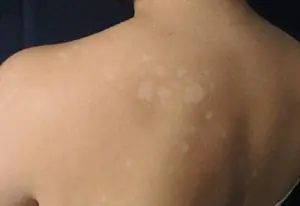
Modern girls are ready to make any sacrifice just to have beautiful and healthy skin with an even, flesh-colored color and characteristic smoothness. However, due to poor lifestyle, poor nutrition and polluted environment, such skin is a real rarity. Therefore, over time, the face and other parts of the body lose their attractive elasticity, and the production of melanin, which is responsible for the skin tone, is significantly reduced. If you notice white spots on the skin, perhaps this indicates the development of a pathological process or is one of the symptoms of more serious diseases, including genetic or allergic ones.
Discolored spots indicate loss of pigmentation, and they can appear on any part of the body, having chaotic sizes and shapes. Their appearance does not cause pain or great concern, so the main nuisance is only of an aesthetic nature. Against the background of dark or tanned skin, such spots stand out very intensely. They can appear in people of all races, regardless of skin tone, gender and other individual characteristics. The progression of the problem causes a significant decrease in self-esteem and leads to psychological discomfort.
Why do white spots appear?
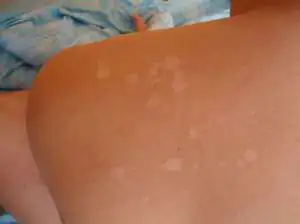
White spots on the body are a very common problem that occurs when the skin becomes discolored due to decreased melanin production. Predisposing factors include:
If we talk about internal reasons, they are represented by the following points:
- Hereditary factor.
- Diseases of the kidneys, liver, intestines and stomach.
- Hormonal imbalances and dysfunction of the hypothalamus and pituitary gland.
- Skin diseases of fungal origin.
- Disruptions in the functionality of the endocrine system and thyroid gland.
- Severe viral infections.
- Lack of certain vitamins and microelements.
- Chronic stressful situations.
Among the external factors:
- Physical damage that has led to deformation of the skin.
- High sensitivity to various household chemicals, synthetic fabrics and other materials.
- Long-term work in hazardous industries and forced contact with toxins.
- Prolonged exposure to ultraviolet rays and tanning.
In most cases, such pigment defects appear due to the progression of a pathological process in the body. To make a correct diagnosis, it is necessary to undergo a comprehensive examination and evaluate the results. If the cause has been discovered, begin to fight it, and do not hide external manifestations and symptoms. In addition, you should first consult with a dermatologist, who will offer to undergo a comprehensive diagnosis and give valuable advice to combat the problem.
There are many diseases, which provoke the appearance of spots in different parts of the body. To know how to deal with them, you should deal with each one individually in advance.
Diseases of fungal origin
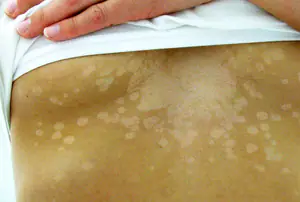
Among the most common and dangerous causes of loss of natural color and pigmentation is a chronic skin disease - pityriasis versicolor. The causative agent of this fungal infection is yeast, which rapidly forms colonies on the skin and produces azelaic acid, which affects melanocytes and blocks the production of melanin. As a result, the skin becomes covered with small round or oval white spots with clear boundaries. The deformation is especially noticeable against the background of tanned skin. Subsequently, the defect increases in size or completely merges, covering large areas. Sometimes the spots spread to the chest, shoulders, neck, back and even groin.
Fungal mycelium continues to loosen the surface layer of the epidermis, so over time the spots begin to itch and flake. However, the inflammatory response is still absent. During the cold season, the defect becomes dark, but after visiting the solarium, everything returns to its original place. A similar situation is observed in the summer, when after prolonged exposure to ultraviolet radiation the spots become especially pronounced. Because of these features, pityriasis versicolor is often called “sun fungus,” which is very common in people living in hot and humid climates.
The fungus cannot be transmitted to other people, since it is formed only due to a weakened immune system, excessive sweating, endocrine system disorders or disruptions in the natural microflora, which can occur with intensive use of antibacterial cosmetics.
At the same time, many experts argue that the risk of infection with pityriasis fungus is also present upon contact with a sick person. Therefore, if the disease is in an acute phase, take a number of precautions by providing the patient with dishes, bedding and hygiene products.
If a fungal infection has been detected, the dermatologist may be able to formulate a suitable treatment regimen, which is based on the use of local antifungal agents in the form of ointments and creams. In advanced cases, complex therapeutic treatment cannot be ruled out when it is necessary take these popular medications:
Pityriasis rosea
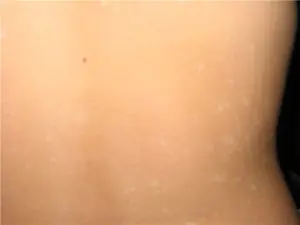
The disease is not transmitted by airborne droplets or any other route, and unpleasant round spots appear due to exposure to viral diseases with reduced immunity. Experts believe that the problem is caused by the herpes virus, and at the initial stage of development a maternal plaque is formed, from which screenings soon emerge, presented in the form of pink spots with clear boundaries.
The spots are not capable of causing pain, so their localization falls on the site of natural folds. After the folds disappear, defects remain on the body. For pityriasis rosea, treatment methods are not as serious as in the previous case. And if you approach the therapeutic course correctly, then all symptoms will disappear within 6-8 weeks. The therapeutic regimen may include the following:
- Glucocorticosteroid ointments.
- Chatterboxes.
- Antibiotics.
- Antihistamines.
- Vitamin complexes.
- Calcium-based preparations.
Lichen alba

Another common disease is pityriasis or pityriasis alba. The first symptoms are represented by the appearance of round spots of pale pink color on the face, neck and hands. In the early stages, the spots are convex, but soon they become flat and white in color. In the summer, the defect is especially noticeable, and especially against the background of tanned skin. When winter comes, the spots begin to peel off, and then the patient experiences unbearable itching and an inflammatory reaction.
The pathology especially often attacks children and adolescents, and the maximum distribution is present in areas with a warm and humid climate.
To return natural pigmentation to the skin after pityriasis, you should undergo a therapeutic course for several months, using ointments with a low content of steroid components, as well as a number of drugs based on pimecrolimus.
Vitiligo
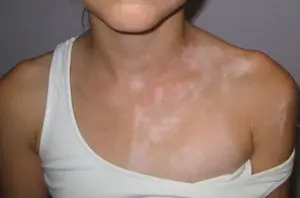
The disease vitiligo often leads to depigmentation of the skin. Why this disease appears and what causes it is not completely known. However, most experts are of the opinion that vitiligo is a dangerous autoimmune disease in which the immune system begins to independently destroy healthy cells that produce melanin (the hormone responsible for pigmentation). As a result, the skin is covered with milky white spots, and there are no unpleasant effects, itching or other troubles. Among the main risk factors:
- Genetic predisposition.
- Autoimmune and hormonal imbalances.
No one is immune from the sudden appearance of white spots due to such a disease. Most often they are localized in open areas of the body, in the armpits and groin. They can be found on the skin near scars, scars or moles.
There are still no effective remedies and drugs to combat vitiligo, although experts have developed a number of medications that reduce the progression of symptoms of the disease.
During treatment, it is necessary to use corticosteroid ointments and antioxidants, which will promote the active production of melanin. In addition, physiotherapeutic methods (PUVA therapy, laser and placental therapy) are especially popular. The techniques activate melanocytes, improving metabolic processes and reducing the severity of spots.
Among the most effective solutions against the symptoms of vitiligo is photochemotherapy with psoralen. The treatment course consists of taking psoralen in the form of tablets or ointments, after which the skin is treated with ultraviolet light. To carry out the procedure, you must visit a specialized clinic where all the necessary equipment is available. However, the cost of treatment is quite high, and the risk of developing serious complications is very high.
Therefore, before starting therapy, the patient must undergo a comprehensive examination to determine possible contraindications.
Experts may attribute another procedure - depigmentation, but it will be effective only in cases where the spots cover more than 50 percent of the skin. For treatment, it is enough to apply special preparations to the skin that have a lightening effect. With their help, you can discolor those areas with pigment.
White spots on the body - how to treat in children
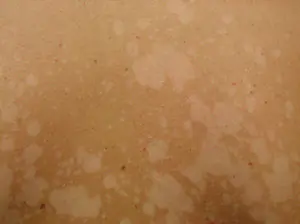
If you are concerned about the question: “How to get rid of white spots on the skin,” be prepared to take drastic measures and work hard. Treatment should be especially thorough when spots appear in children. The fact is that children's skin is very delicate and sensitive, so aggressive methods are ineffective and may even be harmful.
Among the most common diseases that cause the formation of age spots in children, hypomelanosis occupies a leading position. The problem is dyschromia of the superficial (horny) layer of the epidermis, which progresses in the early stages of the baby’s development, or after severe diseases of infectious origin. When treating hypomelanosis, you should use highly effective drugs - retinoids, which can slow down the process of depigmentation. And it is also important to perform a number of cosmetic procedures.
In addition, children often suffer from tumorous sclerosis. With this disease, the face becomes covered with large white spots, the diameter of which reaches three centimeters. The main location is concentrated on the face, skin of the arms and legs. In this case, the spots may indicate a more serious pathology, causing additional complications, including:
- Damage to internal organs.
- Mental retardation.
- Epilepsy.
Like adults, children are exposed to pityriasis versicolor, pityriasis alba or rosea, as well as many other diseases that are more serious in nature.
If you identify alarming symptoms and changes in pigmentation, show your child to a specialist as soon as possible so that he can establish a diagnosis and select quality treatment. Only with this approach can the problem be solved in a short time and without surgical intervention.
To prevent white spots from sunburn, limit your exposure to sunlight. Sunbathe in the morning or late afternoon, when there is little sun activity. The best time for sunbathing is period from 8 to 11 am, or after 4 p.m. At the same time, it is important to moisturize the skin with the help of special creams and lotions that will prevent overdrying.
Follow the rules of skin care, and you will not have to suffer from various problems and diseases.



